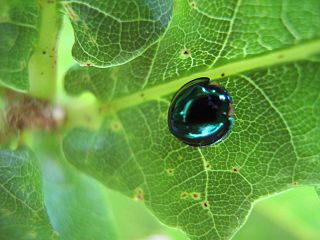
Ladybird Books is a London-based publishing company, trading as a stand-alone imprint within the Penguin Group of companies. The Ladybird imprint publishes mass-market children's books.

Cucujiformia is an infraorder of polyphagan beetles, representing most plant-eating beetles.

Harmonia is a genus of lady beetles belonging to the subfamily Coccinellinae.

The Ladybird is a long tale or novella by D. H. Lawrence.

Coccinella septempunctata, the common ladybug, the seven-spot ladybird, is a carnivorous beetle native to the Old World and is the most common ladybird in Europe. The beetle is also found in North America, Central and Eastern Asia and regions with a temperate climate. Its elytra are of a red colour, but each punctuated with three black spots, with one further spot being spread over the junction of the two, making a total of seven spots, from which the species derives both its common and scientific names.

Coccinellidae is a widespread family of small beetles. They are commonly known as ladybugs in North America and ladybirds in the United Kingdom; "lady" refers to mother Mary. Entomologists use the names ladybird beetles or lady beetles to avoid confusion with true bugs. The more than 6,000 described species have a global distribution and are found in a variety of habitats. They are oval beetles with a domed back and flat underside. Many of the species have conspicuous aposematic (warning) colours and patterns, such as red with black spots, that warn potential predators that they taste bad.

Illeis galbula, the fungus-eating ladybird, is a species of beetle in the family Coccinellidae.

Halmus chalybeus, commonly known as the steelblue ladybird, is a species of ladybird native to Australia. It has a rounded appearance with an iridescent blue/green colouration and is a predator of other insects. It was introduced to New Zealand from Australia in 1899 and 1905 to control black scale and blue gum scale on citrus trees, where it is now common in northern regions. It has also been recorded eating San Jose scale. They are about 3–4 mm long.

Cleobora is a monotypic genus of ladybird native to Tasmania and the southern states of mainland Australia. Its only recognized species is Cleobora mellyi, the Tasmanian ladybird or southern ladybird. It is in the Coccinellini tribe of the subfamily Coccinellinae.

Cryptolaemus montrouzieri, common name mealybug ladybird or mealybug destroyer, is a species of ladybird beetle native to eastern Australia. The beetle feeds on mealybugs and other scale insects, and is used to control those pests on citrus orchards worldwide.

Harmonia conformis, the large spotted ladybird, is a species of ladybird. It has a light reddish appearance and its colouration includes 20 large black spots, 18 of which are found on the elytra. They are quite large for ladybirds, being about 6–7 mm long. It is a predator of other insects, eating aphids as both a larva and imago (adult). It is found in Australia, and has been introduced to New Zealand, where it is common in northern regions. Another member of the same genus, Harmonia antipodum, also occurs in New Zealand. This species, however, is a native and is much smaller and harder to find.

Coccinella leonina, common name orange-spotted ladybird, is a species of ladybird native to New Zealand. It is black with orange spots. A predator species, it is present in a variety of habitats.

Hoangus venustus, commonly known as the flax ladybird, is a species of ladybird beetle that is native to New Zealand, being found at least in the North Island. It can be found on New Zealand flax (Phormium) and Toetoe, reportedly eating the mealybugs that live there. Previously known as Cassiculus venustus, the valid name of the species is now Hoangus venustus.

Novius cardinalis is a species of ladybird beetle native to Australia. It was formerly placed in the genus Rodolia, but that genus was synonymized under the genus Novius in 2020.

Harmonia antipodum, known as the antipodean ladybird, is a species of ladybird beetle indigenous to New Zealand, though sometimes mistaken for a related non-native species, Harmonia conformis. They are a brown colour, and about 3 mm long, while H. conformis is much larger and more conspicuously coloured.

| synonyms = Coccinella 28-punctata Fabricius, 1775 Coccinella sparsa Herbst, 1786 Epilachna gradaria Mulsant, 1850 Epilachna territa Mulsant, 1850 Epilachna vigintioctopunctata Auctt. Epilachna sparsa Auctt.

Rhyzobius ventralis, common names including black lady beetle, gumtree scale ladybird, is a ladybird species endemic to Tasmania and all the mainland states of Australia except the Northern Territory. It is also found in New Zealand, but not naturally. The earliest New Zealand record is Auckland, 1898

Euceraphis betulae, the birch aphid or silver birch aphid, is a species of aphid in the order Hemiptera. It is a tiny green insect with a soft body and wings. It is found living on the European silver birch tree where it feeds and multiplies on the buds and leaves by sucking sap.

Novius koebelei is a species of ladybird beetle native to Australia. It is also present in the wild in New Zealand, where it is of exotic origin. In New Zealand, it was first reported in 2006, having been found in Auckland. It has been known under many names; due to variation in its colouration, it has been described as new six times after its original description in 1892.
Dr Aola Mary Richards was a New Zealand entomologist specialising in the study of New Zealand and Australian cave crickets, or wētā (Rhaphidophoridae), and Australian ladybird beetles (Coccinellidae). She was the first New Zealand woman to gain a PhD in biology.




















